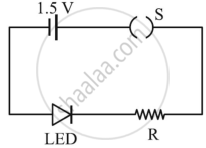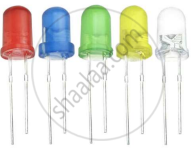Advertisements
Advertisements
प्रश्न
Why a photo-diode is operated in reverse bias whereas the current in the forward bias is much larger than that in the reverse bias? Explain. Mention its two uses.
उत्तर
When a diode is reverse biassed and a small reverse current flows through it, the width of the depletion layer increases.
When light strikes the junction, a large number of electron-hole pairs are generated in the depletion layer due to the wide depletion layer. As a result, in reverse bias, the diode converts more incident light to current, i.e., photocurrent is greater in reverse bias than in forward bias.
Forward bias current is greater than reverse bias current, but the fractional change in reverse bias current is more easily measurable than the fractional change in forward bias current.
As a result, photo-diodes are used in reverse bias.
Uses: In smoke detectors, in bar code scanners.
APPEARS IN
संबंधित प्रश्न
With the help of a neat circuit diagram, explain the working of a photodiode.
Explain with the help of a diagram, how depletion region and potential barrier are formed in a junction diode.
Why is zener diode fabricated by heavily doping both p- and n-sides of the junction?
Explain the formation of depletion layer and potential barrier in a p−n junction.
Explain how a potential barrier is developed in a p-n junction diode.
Write the important considerations which are to be taken into account while fabricating a p-n junction diode to be used as a Light Emitting Diode (LED). What should be the order of the band gap of an LED, if it is required to emit light in the visible range? Draw a circuit diagram and explain its action.
Which one of the following is not the advantage of LED?
Read the following paragraph and answer the questions.
|
LED is a heavily doped P-N junction which under forward bias emits spontaneous radiation. When it is forward-biased, due to recombination of holes and electrons at the junction, energy is released in the form of photons. In the case of Si and Ge diode, the energy released in recombination lies in the infrared region. LEDs that can emit red, yellow, orange, green and blue light are commercially available. The semiconductor used for fabrication of visible LEDs must at least have a band gap of 1.8 eV. The compound semiconductor Gallium Arsenide – Phosphide is used for making LEDs of different colours.
|
- Why are LEDs made of compound semiconductor and not of elemental semiconductors?
- What should be the order of bandgap of an LED, if it is required to emit light in the visible range?
- A student connects the blue coloured LED as shown in the figure. The LED did not glow when switch S is closed. Explain why?

OR
iii. Draw V-I characteristic of a p-n junction diode in
(i) forward bias and (ii) reverse bias
Briefly explain how emf is generated in a solar cell.
How can a photodiode be used to measure light intensity?

